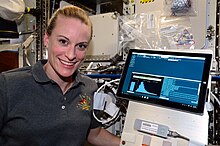User:DaveGod77/Cargo spacecraft
Appearance
Example Cargo
[edit]- Experimentation Equipment
- Phase Change Heat Exchanger
- Heat exchangers are devices used to maintain critical temperatures inside spacecraft. Heat exchangers may remedy the problem of not being able to regulate temperature in space because it has no atmosphere. The phase change heat exchanger has two modes of operation[1]. In the first mode, which uses a freeze cycle, heat exchange fluid is given to the upper flow passageway, which freezes the phase change material at the top[2]. The liquid phase change material at the top is then displaced by the newly-formed phase change material falling to the bottom. In the second mode, which uses a melt cycle, heat exchange fluid is given to the lower passageway to melt the phase change material at the bottom, causing the newly-formed liquid phase change material to be displaced towards the top[2].

Graph generalizing process in a heat exchanger
- Heat exchangers are devices used to maintain critical temperatures inside spacecraft. Heat exchangers may remedy the problem of not being able to regulate temperature in space because it has no atmosphere. The phase change heat exchanger has two modes of operation[1]. In the first mode, which uses a freeze cycle, heat exchange fluid is given to the upper flow passageway, which freezes the phase change material at the top[2]. The liquid phase change material at the top is then displaced by the newly-formed phase change material falling to the bottom. In the second mode, which uses a melt cycle, heat exchange fluid is given to the lower passageway to melt the phase change material at the bottom, causing the newly-formed liquid phase change material to be displaced towards the top[2].
- Nanotube Solar Cell
- A nanotube solar cell is a solar cell designed by the aerospace company Nanoracks that absorbs sunlight more efficiently than traditional solar cells. The Nanotube Solar Cell is three-dimensional, which allows it to have access to the Sun's light in space at every angle while being stationary itself[3]. It is composed of 3-D, carbon nanotube-based photovoltaic devices and copper-zinc-tin-sulfide photo absorbers. They can be implemented into a space station's solar panels to allow for higher power production and usage efficiency[4]. The efficiency of Nanotube Solar Cells also allow for the station to have higher reserves of power to run numerous experiments[5].
- Biomolecule Sequencer
- A biomolecule sequencer is a tool that can be used by crew members to sequence the DNA of microorganisms outside of Earth[6]. Before the production of the biomolecule sequencer, DNA sequencing was limited to Earth because of the equipment and materials required. The new technology eliminates this restriction, with the added benefit of being able to be used in space. The device can also be used to test the DNA of crew members to monitor their health and bodily reactions to space station projects[7]. In the event that a research study needs to be performed on a space station, the biomolecule sequencer can be used to gather needed biological data[8].
- Phase Change Heat Exchanger
- Essential Equipment
- Compressed Air
- Compressed air is used by astronauts to manage their air supply[9]. It is also utilized for research experiments, and to power boosters for both the ISS and other space vehicles[10]. Compressed air equipment sent to the ISS must be very efficient and low power due to the nature of space to break up fluids.
- Compressed Air

- ^ Patent Number 5220954, Longardner, Robert L. & Longardner, William J., "Phase change heat exchanger", issued 1993-06-22
- ^ a b Rostami, Morteza; Zahmatkesh, A. (December 2013). "Heat Transfer Modeling of Phase Change Materials in Multiple Plates Heat Exchanger". Research Journal of Applied Sciences, Engineering and Technology. Maxwell Scientific Organization: 4.
- ^ Rainey, Kristine (2016-06-16). "Cargo Spacecraft to Carry Wide Range of Research". NASA. Retrieved 2021-02-24.
- ^ Rainey, Kristine (2016-06-16). "Cargo Spacecraft to Carry Wide Range of Research". NASA. Retrieved 2021-02-24.
- ^ "Solar Cell Research || The Prashant Kamat lab at the University of Notre Dame". www3.nd.edu. Retrieved 2021-02-24.
- ^ Rainey, Kristine (2016-06-16). "Cargo Spacecraft to Carry Wide Range of Research". NASA. Retrieved 2021-02-24.
- ^ Burton, Aaron; John, Kristen; Botkin, Douglas; Castro, Sarah (March 2016). "The Biomolecule Sequencer Project: Nanopore sequencing as a dual-use technology for crew health and astrobiology investigations". 47th Lunar and Planetary Science Conference: 2.
- ^ John, K. K.; Botkin, D. J.; Burton, A. S.; Castro-Wallace, S. L.; Chaput, J. D.; Dworkin, J. P.; Lupisella, M. L.; Mason, C. E.; Rubins, K. H.; Smith, D. J.; Stahl, S. (2016-10-01). "Biomolecule Sequencer: Nanopore Sequencing Technology for In-Situ Environmental Monitoring and Astrobiology". 1980: 4103.
{{cite journal}}: Cite journal requires|journal=(help) - ^ "The Humble Air Compressor – The Unsung Hero Of Space!". Cosmonaut Experience. 2019-03-03. Retrieved 2021-02-24.
- ^ "The Humble Air Compressor – The Unsung Hero Of Space!". Cosmonaut Experience. 2019-03-03. Retrieved 2021-02-24.

